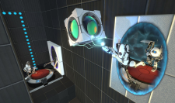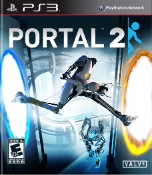I don't now if anyone cares, but if you're going to download this game on your PC then make sure you have at least 11GB free on your hard-drive.
Portal 2 Review
|
|
See PixlBit's Review Policies

On 05/26/2011 at 11:38 AM by Chessa DiMola It's bigger and better than the first with the best puzzle based co-op experience ever. |

Recommended for everyone.
When Portal released back in 2007, it broke the standard conventions of puzzle gaming and revolutionized the genre. With its unrivaled puzzle gameplay and unexpected thrilling story-based foundation, Portal was more than deserving of critical acclaim. So, with all the hype that surrounded Portal, does Portal 2 live up to those same standards and expectations? Absolutely. In every gameplay, story, and environmental aspect, Portal 2 blows its predecessor out of the water. The puzzles are more intricate, the story is gripping, the environments are intriguing, GLaDOS is better than ever, and the co-op quest is one of the best, if not the best, for any game on any system.
Inside a standard looking hotel room as a yet unidentified character (Chell) is where players begin their Portal 2 experience. Seconds later, a talking orb (Wheatley) enters the room and informs players they are almost ready to be processed, so while they wait they should take a nap. Upon waking, players find themselves in a now decrepit room and are informed by a flustered Wheatley that they have been asleep far longer than planned. Because of this, Wheatley explains, they more than likely have acquired a bit of brain damage. After a few lighthearted insults, the "hotel room" is ripped from its location, and as the walls crumble around them, players are allowed their first view of the decimated Aperture laboratory.


The once sleek and sterile looking white testing rooms have been torn to pieces, as live circuits spark amidst the wreckage, and plant life engulfs the area. For a Portal enthusiast like myself, it was shocking, and immediately ignited an interest, almost a need, to know what happened after GLaDOS' demise.
The story driven introduction is a bit of a departure from the fairly organized structure of Portal, but is a welcome one. Whereas the introduction of Portal intentionally created a sense of ambiguity, Portal 2 makes no attempt to hide the fact that it will be a story driven adventure. Had Portal 2 continued the pattern of testing, testing, and more testing, I don't think it could have created such a thrilling and dynamic play experience. Portal 2 carries over the core gameplay mechanics of its predecessor, but vastly overhauls the player's journey from point A to point B.
For Portal veterans, the testing chambers will seem like familiar territory at first glance; once GLaDOS pulls the broken, sparking rooms back together that is. Although a few original Portal testing elements have returned, including wise-cracking turrets and the companion cube, the majority of them are brand new. Whereas Portal was focused on twitch puzzles and those that relied on gravity, Portal 2 redefines the gameplay by introducing an assortment of new tools.
Bridges ("Hard Light Bridges"), lasers ("Thermal Discouragement"), laser "Redirection Cubes", multi-directional gravity auras ("Excursion Funnels"), three different types of gels ("Propulsion Gel", "Repulsion Gel", "Conversion Gel"), and launch pads ("Aerial Faith Plates") comprise Portal 2's new puzzle elements. While I don't want to delve too deeply into the minutiae of every previously listed element, some description can be helpful. Click here for the details.


Each of these are introduced at a particular point in the game, which serves to not overload players initially and, more importantly, keeps evolving and differentiating the gameplay. Were it not for the introduction of such a wide assortment of new puzzle solving artillery, the first section of Portal 2 would have felt much longer than it did. I say first section because, similar to Portal, Portal 2 takes a wild turn, sending players into a much different gaming experience than they could have anticipated.
Part B of Portal 2 takes players out of the testing chambers into the literal depths of Aperture science, where they realize the testing chambers are nothing more than a small cog in a much larger machine. For the first time, players are given a roundabout explanation of Aperture's history through the original founder, Cave Johnson, voiced by J.K. Simmons (J. Jonah Jameson in Spider Man). It's an entertaining and slightly sad view of the company's roots, which becomes a dark twisted tale as players continue to climb through the many different layers of Aperture Laboratories. The locations players will explore are incredibly designed, full of small intriguing pieces of Aperture lore, and the puzzles are nothing short of phenomenal.
Portal 2 starts out good, gets better as it goes on and, though it drags a tiny bit towards the end, finishes with a bang. Rest assured that throughout the entire spectacular adventure, GLaDOS will be there to emotionally discourage and torment our poor main character. Don’t worry though; she gets hers, for a while at least.


But wait, there's more! As if a mind-blowing single-player quest wasn't enough, Valve had to go and create a cooperative experience that is completely different from the story driven single-player quest, but equally as enthralling. As a quick side note, I would strongly urge players to complete the main campaign first, as it briefly introduces the purpose for the co-op characters Atlas and P-Body, and makes the co-op ending that much more intriguing.
Before even beginning the quest, players have multiple options for how they can connect with other players. For those like me who enjoy playing games with people in the same room, there's a local co-op option. For everyone else, there's online co-op, and for those who want to play with someone on a different console, PS3 owners can hook up with a PC Portal 2 player.
The quest itself takes players through five sets of challenges, split between several different areas. Each set generally tends to focus on one main gameplay element, though others are thrown in to add another dimension of challenge. All of the puzzles in a set take place within the familiar testing rooms, with the exception of the final puzzle in a set. This challenge is based in the "outside world" (those who played through the single-player quest first will recognize the locations) and will require players to complete a personal request for GLaDOS. Fulfilling all of GLaDOS' requests results is an intriguing conclusion, to say the least.
Each of the challenges requires four portals to complete, two from each player. Unlike the single-player quest, many of the cooperative challenges will require each player to perform completely independent tasks initially, only to bring the effort together at the end. Due to this, players will often become separated in a level, and need to communicate with one another based on a player's individual view (this obviously isn't an issue with local co-op). To solve this problem, player's can throw up one of several markers, indicating to a second player what to do in a particular spot. These markers include indicators such as shooting a portal or placing an object.


While the puzzles mostly follow general Portal convention, as they go on, the dynamic between both players will change drastically. Initially, it's obvious how two players will cooperate in order to solve a puzzle; one person gets the other across, then that person gets them across, and so on and so forth. Eventually the puzzles will feature elements intentionally designed to throw players off, and vary so much that all of the possible answers will make players question even the simplest solutions.
Oh, and just because there are no humans around to demean doesn't mean GLaDOS isn't just as much of a highlight in co-op as she is in single player. Rest assured that her tactless charm is ever present. In fact, she'll go to extra nasty lengths to pit two players against one another by harshly insulting one and over-praising the other. Annoying her back is as easy as performing one of Atlas' and P-Bodys' several human-like gestures, which include high-fiving, hugging, dancing, and playing rock, paper, scissors.
With a thrilling single-player quest and one of the best cooperative experiences ever seen to date in a video game, Portal 2 is an all encompassing, mind-blowing gaming experience. It's got action, intrigue, mystery, personality, another wonderfully addicting ending score, and the best puzzle solving I've ever encountered. If you have yet to experience the series, first tackle Portal and then treat yourself to Portal 2. Hands down it's one of the most original, engaging, and incredible gaming experiences we'll see this year.
After scoping out comparable in-game images between all three versions, it's safe to say that the PC offers the best graphics, whereas the 360 version offers the worst. While the PS3 graphics are slightly rougher than those found on the PC, the 360 version of Portal features far greater disparities.
As far as co-op benefits go across all three systems, the PS3 version offers the most versatile experience. While the 360 offers local co-op, and both the 360 and PC feature online play, the PS3 offers both of those co-op methods, with the added bonus of a Steam key inclusion and the option to play online co-op from PS3 to PC.









Side By Side - Graphics and Co-Op